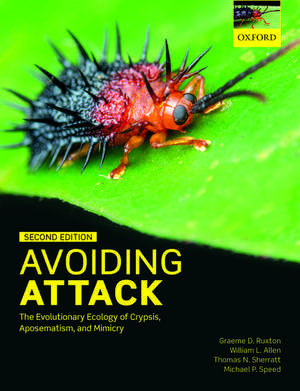Avoiding Attack: The Evolutionary Ecology of Crypsis, Aposematism, and Mimicry
Autor Graeme D. Ruxton, William L. Allen, Thomas N. Sherratt, Michael P. Speeden Limba Engleză Paperback – 9 aug 2018
| Toate formatele și edițiile | Preț | Express |
|---|---|---|
| Paperback (1) | 357.19 lei 32-37 zile | |
| OUP OXFORD – 9 aug 2018 | 357.19 lei 32-37 zile | |
| Hardback (1) | 648.22 lei 11-16 zile | |
| OUP OXFORD – 17 aug 2018 | 648.22 lei 11-16 zile |
Preț: 357.19 lei
Preț vechi: 435.06 lei
-18% Nou
Puncte Express: 536
Preț estimativ în valută:
68.35€ • 71.56$ • 56.69£
68.35€ • 71.56$ • 56.69£
Carte tipărită la comandă
Livrare economică 31 martie-05 aprilie
Preluare comenzi: 021 569.72.76
Specificații
ISBN-13: 9780199688685
ISBN-10: 0199688680
Pagini: 292
Ilustrații: Over 70 illustrations
Dimensiuni: 189 x 247 x 15 mm
Greutate: 0.74 kg
Ediția:2
Editura: OUP OXFORD
Colecția OUP Oxford
Locul publicării:Oxford, United Kingdom
ISBN-10: 0199688680
Pagini: 292
Ilustrații: Over 70 illustrations
Dimensiuni: 189 x 247 x 15 mm
Greutate: 0.74 kg
Ediția:2
Editura: OUP OXFORD
Colecția OUP Oxford
Locul publicării:Oxford, United Kingdom
Recenzii
we enjoyed reading this new edition and cannot wait to recommend it to our students and colleagues ... the authors have done an excellent job at synthesizing the vast literature on predator-prey interactions into one relatively compact text. This makes this book a must read for any scientist or non-scientist who has any level of interest in the subject.
This is the second edition of Avoiding Attack now thoroughly revised and updated with the help of Will Allen. Using the predatory sequence as a road map through classes of anti-predator defenses, 14 chapters systematically address the ways in which prey avoid detection, thwart recognition, dodge attack and prevent consumption. In the sense of being a comprehensive and thoughtful synthesis of a growing sub-field in behavioural/evolutionary ecology, it is an absolute tour de force.
This is the second edition of Avoiding Attack now thoroughly revised and updated with the help of Will Allen. Using the predatory sequence as a road map through classes of anti-predator defenses, 14 chapters systematically address the ways in which prey avoid detection, thwart recognition, dodge attack and prevent consumption. In the sense of being a comprehensive and thoughtful synthesis of a growing sub-field in behavioural/evolutionary ecology, it is an absolute tour de force.
Notă biografică
Graeme Ruxton is Professor of Evolutionary Ecology at the University of St Andrews, Scotland. He has broad interests in behavioural ecology, but mostly focusses on predator-prey interactions. His main means of investigation is in various types of theoretical modelling, but this is generally linked to empirical data collection in the field or laboratory. His interests are wide in terms of ecosystems and taxonomy too, and he has occasionally published speculations on the ecologies of extinct species. Graeme's interest in predator-prey interactions has grown to include between-species communication more generally and he has a strong interest in how plants interact with animal antagonists and mutualists.William Allen is an evolutionary ecologist who investigates antipredator defences at macroecological and macroevolutionary scales. His interdisciplinary training at the University of Bristol in human, animal, and machine vision has allowed him to apply novel techniques to understanding the visual ecology of defences in diverse taxa, including felids, reptiles, and ungulates. Other research interests include intraspecific visual signalling in primates and life history evolution. He currently teaches courses on sensory ecology and the evolution of tetrapods.Tom Sherratt has a broad range of interests in the fields of behavioural and evolutionary ecology, notably predator-prey interactions, the evolution of senescence and the evolution of cooperation. Members of the Sherratt lab conduct both field and laboratory experiments, but they also attempt to develop and test biologically relevant theory. Tom also teaches courses in statistics and computer modelling.Michael Speed is an evolutionary biologist with longstanding interests in predator-prey relationships, evolution, and phylogenetics. He studied at Leeds University, where he began his work on the evolution of signalling in mimicry systems and currently lectures in evolution and behaviour at the University of Liverpool, where he is also Head of the School of Life Sciences.
